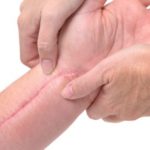 Scar Tissue Release
Scar Tissue Release
When first evaluating a new patient, I always ask about their surgical history. Not only am I trying to understand what their bodies have been through, but I am also interested in knowing where to locate any existing scars.
Scar tissue is the method by which the body is equipped to close up wounds—whether traumatically or surgically induced. When I was in physical therapy school, I was taught that once scar tissue had fully matured (in about one year’s time), it was unable to be changed, stretched, or remolded in any way. After graduation, the instructor who taught my first continuing education course begged to differ. It was then that I learned that, even decades later, people’s surgical scars could be “manually manipulated” so as to bring healing to their physical ailments.
When it comes to getting physical therapy following orthopedic surgical procedures (e.g. total knee/hip replacement, arthroscopy of the shoulder/knee, fractures that require screws and/or metal plates to repair), it is vital that the surgical sites—once healed—be massaged and tensioned in a tri-planar fashion in order to restore full motion, absolve pain, and regain strength.
It is also routine practice for me, as a manual physical therapist, to “free up” any existing abdominal and chest scars (e.g. Caesarian section, appendectomy, and breast reconstructive surgery) in order to bring about full recovery for a patient’s neck, low back, or shoulder pain complaints. The same is true for spinal surgery scars.
A clear sign that your scar tissue is indeed “bound down” (attached to the underlying fascia, muscles, organs, etc.) is that your skin dimples or puckers around/along your scar. Scars that have healed well should look smooth when you are standing in front of a mirror. They should not pull or wrinkle when your limbs are moved about, either.
Yet even when a scar looks good to the eye, it is often not good to the touch—to a professional’s touch. If mobility is lacking in any direction when a scar is stretched, it could be causing pain, weakness, and compensation of movement elsewhere in the body.
So if you are experiencing pain either locally, nearby, or on the “flip side” of your body from the scar (e.g. neck or shoulder pain with chest or abdominal scars or low back pain with a C-section scar), find yourself a physical therapist with a skilled pair of hands. Have them set out to restore your scar tissue’s mobility so that you can be restored to a pain-free, fully functioning state!